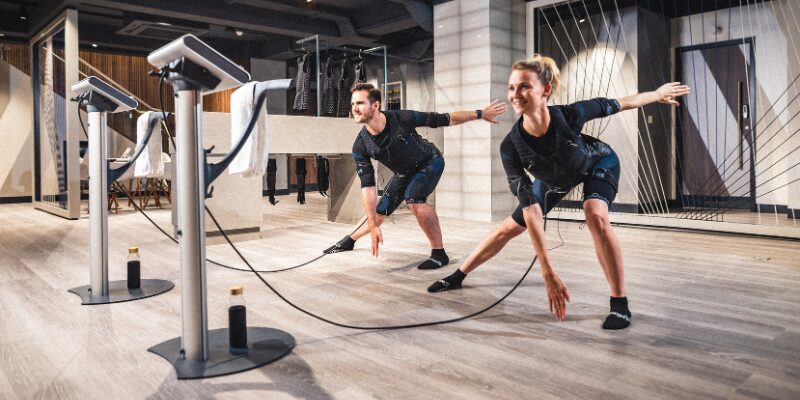Imagine reducing your gym time to just 15 minutes and achieving results. EMS therapy could be the shortcut you’ve been searching for. It acts as a turbo boost for your muscles, with studies indicating users in a six-week squat program experienced greater strength gains than those using traditional methods. The benefits of EMS therapyalso include the ability to burn up to 500 calories in a single session, ideal for those with busy lifestyles.
The FDA acknowledges EMS can temporarily tone muscles, but it is not a magic solution. It should be viewed as a tool, not a complete fix. Safety is a priority: individuals with pacemakers or who are pregnant should avoid it, as well as those with concerns about the lower back and neck. While rare, muscle overuse injuries can occur, yet with proper guidance, many find it transformative.
Key Takeaways
- EMS sessions as short as 15-20 minutes can match hours of traditional exercise, per user reports.
- Research shows EMS users in squat programs gained more strength than non-users, but long-term results need combined workouts.
- Temporary muscle gains are backed by the FDA, but risks like burns or irritation exist with improper use.
- Over 1,600 monthly searches highlight growing interest in EMS’s efficiency, but check device safety ratings first.
- Pair EMS with your routine—like 1-2 weekly sessions plus cardio—to balance speed and safety.
What is EMS Therapy?
EMS therapy employs gentle electrical pulses to stimulate muscles beyond what traditional exercise can achieve. Envision yourself wearing a snug suit with electrodes strategically positioned over key muscle groups. These electrodes emit mild signals, inducing muscle contractions akin to a workout, yet without the need for physical exertion. This method offers electro muscle stimulation benefits such as accelerated recovery and enhanced strength.
Understanding Electrical Muscle Stimulation
Electrical muscle stimulation acts as a wake-up call for your muscles. Electrodes replicate the brain’s signals, prompting deeper muscle engagement than voluntary movements alone. This non-invasive technique is ideal for both rehabilitation and fitness purposes. Here’s a breakdown of how it functions:
- Electrodes adhere to the skin, transmitting low-voltage pulses.
- Muscles contract and relax in sync, augmenting circulation and strength.
- Endorphins released during sessions naturally alleviate pain.
Curious about the sensation? It’s akin to a gentle tapping or vibration, devoid of discomfort. Many users find it invigorating, not painful. Sessions typically last between 10–15 minutes, making it a convenient option for those with hectic schedules.
Whether you’re recovering from surgery or looking to enhance your fitness, EMS therapy is adaptable to your needs. Intrigued by real-world outcomes? Research indicates that EMS aids in muscle tone restoration and shortens recovery periods. It’s also favored by athletes and individuals managing chronic pain. Are you prepared to explore how it could benefit you?
The Science Behind EMS Therapy
Ever ponder the mechanism behind those electrical pulses leading to tangible results? Let’s see some EMS Training Before and After Photos. At its essence, EMS replicates your body’s natural signals, acting as a coach for your nerves. These electrical impulses instruct muscles to contract, augmenting blood flow and nutrient delivery to fatigued or injured zones. This phenomenon is backed by empirical evidence; for example, a 2021 analysis of 381 trials demonstrated EMS’s efficacy in pain reduction surpassing placebo effects. Concurrently, it enables muscles to contract on demand, engaging more fibers than conventional workouts.
Key Principles of Electrical Muscle Stimulation
- EMS activates muscles deeper than voluntary effort—picture targeting those stubborn lower-back muscles you can’t isolate during a workout.
- It triggers “muscle recruitment” to engage even the hardest-to reach fibers, boosting strength without added strain.
- Electrical signals also reduce recovery time by improving circulation, which explains why athletes use it post-injury (check out how this works in action.
Envision your nervous system as a network—EMS simply amplifies its signals. This technology doesn’t merely “feel” like exercise; it’s substantiated. A recent study monitored 41 individuals over 8 weeks, revealing the EMS group experienced 5% greater muscle thickness in targeted areas. Notably, the FDA endorses its safety for rehabilitation, with risks such as skin irritation being uncommon when used correctly.
So, why is this significant? EMS technology advantages empower you to work smarter, not harder. It serves as a potent tool for both injury rehabilitation and fitness enhancement. With research affirming its benefits for seniors, this is more than a fleeting trend—it’s the embodiment of scientific principles in action.
Benefits of EMS Therapy for Fitness Enthuasiasts
Imagine achieving strength without the need for extended gym sessions. EMS training benefits extend beyond mere convenience, revolutionizing muscle development. Let’s explore why this technology is a paradigm shift.
Enhanced Muscle Strength and Tone
EMS therapy engages 90% of muscle fibers during each session, surpassing traditional workouts by half. This concentration of effort ensures every benefit of EMS therapy is maximized, not diluted. Here’s how it operates:
- Time-efficient results: A 15–20 minute session at studios like Manduu or Epulse Fitness equates to 90 minutes of weightlifting. No need for marathon gym sessions.
- Targeted gains: Focus on specific areas like arms, core, or legs with unparalleled precision. Users witness definition in weeks, where traditional weights alone faltered.
- Science-backed strength: A European Journal study confirms EMS increases muscle activation, benefiting even older adults in building tone safely.
A 15-minute EMS session at Manduu can amplify your workout’s impact 3x over. This is why athletes and novices alike witness accelerated progress.
Consider EMS as a muscle turbocharger. It’s not a replacement for weightlifting but a means to enhance performance without the exhaustion. Are you ready to achieve gains without the usual effort?
EMS Therapy for Muscle Recovery
Ever felt so sore after a workout you couldn’t walk? EMS therapy benefits for muscle recovery could be your solution. It acts as a turbo boost for your body’s natural healing process. Let’s explore how it works—and why athletes and physical therapists trust it.
“EMS therapy uses electrical impulses to reduce inflammation and enhance blood flow, helping muscles heal faster,” says Dr. Lisa Nguyen, a sports medicine specialist. “It’s like giving your body a reset button.”Reducing Muscle Soreness
Here’s how it helps:
- EMS boosts circulation, flushing out lactic acid—the culprit behind that post-workout burn.
- Electrical pulses ease knots and spasms, easing stiffness.
- Endorphins released during sessions act as nature’s painkillers.
Studies show mixed results—some athletes report 50% faster recovery times. But consistency matters: most see gains after 4-6 weekly sessions. And yes, even beginners can try it. Start with 10-15 minute sessions post-workout.
Pro tip: Pair EMS with stretching. The electrical pulses make your muscles more receptive to flexibility gains. Ready to try it? Explore how EMS stacks up against other methods here. Your muscles deserve a smarter recovery plan.
Potential Advantages for Athletes
Do you feel like your workouts plateau? EMS therapy could be the catalyst you need. It promises to enhance your vertical jump by 20% or cut sprint times by seconds, all without the need for weights. Research affirms that electric muscle stimulation (EMS) can deliver the performance enhancements even elite athletes seek.
Studies reveal EMS can boost vertical jumps by +25% and sprint times by 4.8%. A 2016 study, highlighted by Continuum Centre, demonstrated athletes using EMS in a six-week squat program outperformed their peers. Today, devices like the Marc Pro or PowerDot empower professionals to maintain peak performance amidst demanding schedules.
- Vertical jumps improved 21.4% (squat jumps) to 12% (drop jumps)
- Sprint times dropped up to 4.8% in elite athletes
- Strength gains matched traditional training when volume matches
Elite teams, including the NFL, now integrate EMS into their training regimens to preserve power between games. Even when athletes are injured, EMS helps maintain muscle strength, as it takes double the current to activate injured muscles but prevents atrophy. Unlike traditional weight training, EMS doesn’t fatigue the central nervous system, allowing for quicker recovery and enhanced power.
Consider EMS as a strategic addition to your training regimen, not a replacement. By incorporating EMS sessions into your routine, you can achieve new heights. The success hinges on consistent application and tailored programs specific to your sport. Professional athletes report feeling more agile post-workout and post-travel, with a significant reduction in cramping, up to 30%.
EMS Therapy and Weight Loss
Seeking to enhance your metabolism and lose weight without extensive gym time? EMS therapy advantages could be the solution you’ve been searching for. Research indicates that electro muscle stimulation benefits can initiate fat loss by engaging muscles more profoundly than conventional exercises.
A 2022 investigation, involving 60 participants, divided them into EMS and TENS groups for a 12-week period. The EMS group experienced a notable reduction in waist circumference, averaging 5.2 cm, compared to 2.9 cm for the TENS group. Remarkably, 70% of EMS users achieved a waist reduction of over 4 cm, whereas only 33% in the TENS group did. EMS users also exhibited enhanced fat metabolism, as evidenced by increased fasting free fatty acid levels.
- EMS sessions last 66 minutes, 5 days weekly—but most users spend just 15-20 mins per session (check out this deep dive for more insights)
- Pair EMS with a protein-rich diet to amplify results—muscle activation plus smart eating maximizes fat loss
EMS is not a quick fix but a powerful tool to enhance your efforts. It acts as a personal trainer for your muscles, driving them to exert themselves beyond their natural capacity. The study revealed minimal risks, yet it is imperative to consult a healthcare professional before starting.
Are you prepared to give it a try? Begin with 1-2 sessions per week, complemented by a mindful diet. Even minor adjustments can significantly boost your metabolism. This is your personal journey. Approach it with caution and let EMS be your ally in achieving your fitness goals safely and efficiently.
Safety and Considerations in EMS Therapy
Embarking on EMS therapy necessitates an understanding of personal limitations. This involves identifying who should refrain from initiating treatment and ensuring safety throughout the process.
Who Should Avoid EMS Therapy?
- Individuals with pacemakers or defibrillators (FDA advises against use)
- Pregnant individuals
- Those with severe heart, nerve, or respiratory conditions
Even for those cleared to use EMS, there are inherent risks. For instance, rhabdomyolysis—a rare but severe muscle breakdown—can occur with excessive use. It is advisable to begin with caution: sessions should not exceed 25 minutes, and at least two rest days should intervene between each session. Adequate hydration and attentiveness to bodily signals are imperative.
Proper device selection is critical. Opt for devices with FDA certification. Adhere to guidelines, such as initiating at low intensities. As the body adapts, studies indicate a decrease in muscle strain indicators with consistent, cautious application.
Before engaging with EMS therapy, it is essential to consult a healthcare professional if you have diabetes, open wounds, or a history of blood clots. EMS should be complemented with rest and nutrition for optimal results. This technology is not a standalone solution. Always prioritize caution—your health is the utmost priority.
EMS Therapy Compared to Traditional Workouts
Ever ponder the comparison between EMS and your typical gym regimen? Let’s dissect it. The benefits of EMS therapy are most pronounced when time is of the essence. A mere 20 minutes can equate to an hour-long session, perfect for those with packed schedules. EMS is remarkable, activating up to 90% of muscle fibers, significantly surpassing traditional training’s 40%. This results in quicker muscle strength and tone enhancements, all without the need for heavy weights.
- Efficiency: EMS condenses into 20 minutes, penetrating muscles more profoundly than conventional exercises.
- Safety: Its low-impact nature minimizes joint stress, making it ideal for seniors or those in recovery
- Science-backed results: EMS has been shown to enhance strength as effectively as weightlifting, and sometimes even more rapidly. A study demonstrated it outperformed traditional training in preserving muscle fibers.
EMS training benefits extend beyond mere time efficiency. It offers a deeper engagement with muscle development.
Even elite athletes, such as Novak Djokovic, incorporate EMS into their training regimens, underscoring its effectiveness. Yet, it’s not a replacement for traditional exercises. EMS excels in recovery, rehabilitation, or when time is scarce. It’s a valuable addition to your workout arsenal, designed to enhance your routine and overcome plateaus. Remember, it’s a tool, not the sole component of your fitness regimen.
Integrating EMS Therapy into Your Routine
Are you ready to incorporate EMS therapy into your fitness regimen? We’ll explore how to seamlessly integrate the EMS therapy benefits for athletes and the advantages of electric muscle stimulation into your daily activities. Begin with small steps, envisioning it as a supplement to your workout regimen.
“The stimulation current should be biphasic, with sessions lasting at least 20 minutes, 3 times weekly for 5–6 weeks,” emphasizes research by Paillard. These guidelines ensure your body adapts safely.
Here’s your game plan:
- Begin with 10–15 minute sessions 2–3 times a week, matching your current workout schedule.
- Pair EMS with rest days to boost recovery without overexertion.
- Use devices like Compex’s FIT series for full-body workouts or CoreBelt for targeted core strengthening.
- Always warm up first—think a 5-minute walk—to prep muscles for stimulation.
Timing is key. Morning sessions can energize you, while evening use promotes relaxation. For desk workers, a 10-minute lunch break session with low intensity eases tension. Gradually increase intensity, like tuning a guitar string, to ensure smooth muscle adaptation.
Consider whether you aim to replace or complement your current routine. View EMS as a supplement, not a replacement. Combine it with yoga or swimming for well-rounded benefits. Consistency is more important than intensity. Even 15 minutes a few times weekly can make a significant difference.
EMS Devices: What to Look For
When selecting an EMS device, it’s essential to look beyond the price. Identifying tools that offer genuine EMS technology advantages while maintaining quality is imperative. This guide will help you discern the best options available.
“Using unregulated devices can lead to burns, bruising, or skin irritation,” warns the FDA. “Always check for proper certification before purchasing.”Features of Quality EMS Devices
- FDA Clearance: Opt for devices like Compex, which adhere to rigorous safety protocols. Their FDA 510(k) approval guarantees consistent EMS training benefits for muscle stimulation.
- Targeted Electrodes: High-end units, favored by NFL athletes, feature multiple electrode placements. These target deep muscle fibers, providing more than just superficial pain relief.
- Program Variety: Devices with pre-set routines for recovery, strength, or endurance eliminate the need for professional guidance. Compex’s sport-specific programs have been shown to increase muscle strength by 15%.
Be cautious of TENS units marketed as EMS. TENS units only mask pain temporarily, whereas EMS devices are designed to enhance muscle strength. Inquire if the device stimulates all muscle fiber types. Professional EMS systems engage both slow-twitch (endurance) and fast-twitch (power) fibers, unlike cheaper alternatives.
Elite trainers rely on devices with EMS technology advantages such as adjustable pulse widths. These mimic natural nerve signals, essential for avoiding discomfort. It’s also important to note that individuals with pacemakers or pregnant women should not use these devices without medical clearance.
Future of EMS Therapy in Fitness
Envision a fitness landscape where EMS technology evolves in tandem with your body’s needs. The advent of wireless systems and AI-driven programs heralds a new era of EMS customization. Soon, devices will dynamically adjust intensity and patterns to align with your fitness objectives, whether it’s muscle building or injury recovery. Wearable technology pioneers are exploring prototypes equipped with sensors that monitor muscle fatigue and recovery, ensuring each session is tailored to your specific requirements.
Innovations on the Horizon
Current research indicates that daily EMS users experience a 0.8kg increase in muscle mass compared to non-users, underscoring its efficacy. The forthcoming EMS technology promises to transcend these boundaries. Envision apps that harmonize with your exercise routines, guiding you through customized protocols based on your progress. For instance, systems akin to those employed in recent clinical trials could soon become the norm, facilitating quicker recovery by precisely targeting pain areas.
EMS’s role in addressing the needs of aging populations is also gaining traction. Initial studies suggest it can aid older adults in maintaining mobility, significantly reducing the risk of falls by fortifying critical muscles. Given that fall is an opportune time to initiate EMS training, as advocated by Brute Suits, the time is ripe to lay the groundwork for sustained benefits.
The fundamental advantages of EMS therapy can be seen in the before and after pictures—quicker muscle recovery, enhanced strength, and metabolic enhancements verified in 8-week studies—remain steadfast. As technology advances, the distinction between conventional workouts and EMS-enhanced training will diminish. Whether you’re recovering from surgery or striving for peak performance, EMS’s future extends beyond mere fitness—it unlocks untapped human capabilities



































